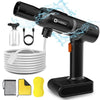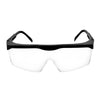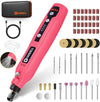Rotary Tool vs. Die Grinder: Which One is Better?

Rotary tools and die grinders are both popular among DIY enthusiasts, hobbyists, and professionals alike for their versatility and ability to tackle a variety of tasks. While these tools share some similarities, they also have key differences that can impact their performance and suitability for different tasks.
For those looking to compare the two tools, it's important to understand the strengths and weaknesses of each.
In this article, we will analyze their pros and cons from different perspectives to help you choose tools better.
Rotary Tools

Overview
Rotary tools are handheld power tools that utilize a spinning motion to accomplish various tasks. These versatile tools are used in a wide range of applications, including woodworking, metalworking, jewelry making, and more. A rotary tool typically features a motor that drives a spindle or collet, which holds various attachments or bits.
Types of Rotary Tools
There are several types of rotary tools available, ranging from basic models to more advanced and specialized versions. Some rotary tools are corded, while others are cordless and run on rechargeable batteries. Some of the most popular rotary tool brands include Dremel, WEN, and Black & Decker.
Benefits of Rotary Tools
One of the main benefits of rotary tools is their versatility. With the ability to switch out different rotary tool accessories, rotary tools can be used for a wide range of tasks. They are also relatively affordable, making them accessible to both professionals and hobbyists. Additionally, rotary tools are compact and lightweight, making them easy to use and maneuver.
Limitations of Rotary Tools
While rotary tools are versatile and useful, they do have some limitations. For example, they may not be powerful enough for heavy-duty applications, such as cutting through thick metal or concrete. Additionally, some rotary tools may not be durable enough for extended use, particularly in professional settings.
Choosing the Right Rotary Tool
When choosing a rotary tool, it's important to consider your specific needs and applications. Think about the tasks you will be using the tool for, and choose a model with the appropriate power, speed, and accessories. Consider the brand and reputation of the tool, as well as any warranties or guarantees offered by the manufacturer.
Therefore, Hardell is highly recommended. Their high-quality tools are built to last and offer a range of power and speed options, as well as a variety of accessories to fit your specific needs. Hardell also offers excellent customer service and warranties on their products, giving customer peace of mind and confidence in your purchase.
Die Grinder

Overview
Die grinders are handheld power tools that are used for grinding, sanding, and shaping various materials such as metal, wood, and plastics. They are commonly used in metalworking applications such as machining, grinding, and polishing. Die grinders typically feature a motor that drives a collet, which holds various grinding and cutting attachments or bits.
Types of Die Grinders
There are several types of die grinders available, ranging from basic models to more advanced and specialized versions. Some die grinders are corded, while others are cordless and run on rechargeable batteries. Some of the most popular die grinder brands include Makita, DeWalt, and Milwaukee.
Benefits of Die Grinders
One of the main benefits of die grinders is their power and versatility. With high speeds and the ability to switch out different attachments and accessories, die grinders can be used for a wide range of tasks. They are also relatively affordable, making them accessible to both professionals and hobbyists.
Additionally, die grinders are compact and lightweight, making them easy to use and maneuver. Limitations of Die Grinders
While die grinders are powerful and versatile, they do have some limitations. For example, they may not be suitable for precision tasks such as carving or engraving. Additionally, some die grinders may not be durable enough for extended use, particularly in professional settings. Choosing the Right Die Grinder
When choosing a die grinder, it's important to consider your specific needs and applications. Think about the tasks you will be using the tool for, and choose a model with the appropriate power, speed, and accessories. Consider the brand and reputation of the tool, as well as any warranties or guarantees offered by the manufacturer.Related reading:Benefits of mini battery chainsaw
Comparing Rotary Tools and Die Grinders
Rotary tools and die grinders have some similarities in their design and function, but there are also some notable differences that set them apart. In this section, we will compare and contrast the two tools based on various factors to help you decide which tool is best suited for your needs.
Power and Speed
Rotary tools and die grinders both have powerful motors, but die grinders are generally more powerful than rotary tools. Die grinders typically have motors that range from 1/4 to 1/2 horsepower, while rotary tools have motors that range from 1/8 to 1/3 horsepower. Die grinders also have higher speeds than rotary tools, which makes them better suited for heavy-duty tasks that require high-speed cutting, grinding, and polishing.
Size and Weight
Die grinders are generally larger and heavier than rotary tools. They are designed for heavy-duty tasks and are built to withstand the rigors of daily use. Rotary tools, on the other hand, are smaller and lighter, making them easier to handle and more versatile. They are ideal for working in tight spaces and for tasks that require precision and control.
Precision and Control
Rotary tools are more precise and offer better control than die grinders. They are ideal for tasks that require intricate detail work, such as carving, engraving, and etching. They are also excellent for sanding and polishing small and delicate items. Die grinders, on the other hand, are better suited for heavy-duty tasks that require more power and speed, such as grinding and shaping metal.
Versatility and Range of Attachments
Both rotary tools and die grinders are versatile tools that can be used for a wide range of applications. However, rotary tools are generally more versatile than die grinders because they can be used with a wider range of attachments. Rotary tools come with a range of attachments, including cutting wheels, sanding drums, polishing pads, and engraving bits, among others. Die grinders, on the other hand, are generally used with grinding wheels, cut-off wheels, and sanding discs.
Examples of Applications
Rotary tools are well-suited for tasks that require precision and control, such as carving, engraving, and etching. They are also excellent for sanding and polishing small and delicate items. Examples of applications include jewelry making, model making, and woodworking. Die grinders, on the other hand, are better suited for heavy-duty tasks that require more power and speed, such as grinding and shaping metal. Examples of applications include metalworking, automotive repair, and construction.
In conclusion, both rotary tools and die grinders are versatile and powerful tools that can be used for a wide range of applications. The choice between the two depends on the task at hand and the level of precision, control, and power required. Rotary tools are ideal for tasks that require precision and control, while die grinders are better suited for heavy-duty tasks that require more power and speed.related rading:Difference between 4 inch and 6 inch mini chainsaw
User Preferences and Experience
While there are objective differences between rotary tools and die grinders, personal preferences and experience can also play a significant role in choosing between the two tools.
Some people may prefer the smaller size and more compact design of rotary tools, as they can be easier to handle and use for fine detail work. Others may prefer the heavier, more powerful feel of die grinders, which can be better suited for heavy-duty tasks and larger projects.
Experience can also influence a person's choice, as someone who is more experienced with one tool may feel more comfortable using it and be able to achieve better results with it. However, it's important to keep an open mind and consider the advantages and disadvantages of both tools for each specific project or task.
Here are some tips for those trying to decide between rotary tools and die grinders:
Consider the type of work you will be doing

If you need to do fine detail work or work with small parts, a rotary tool may be more suitable. If you need to do heavy-duty grinding or cutting, a die grinder may be a better choice.
Evaluate the attachments you will need
Look at the range of attachments available for both rotary tools and die grinders and consider which ones you will need for your project. This can help you choose the tool that will best meet your needs.
Think about ergonomics
Consider the size, weight, and grip of each tool and choose the one that feels most comfortable and natural in your hand.
Take into account your level of experience
If you are a beginner, a rotary tool may be a better choice as it is more versatile and easier to use. If you are experienced and comfortable with heavy-duty tools, a die grinder may be a better option.
Ultimately, the choice between a rotary tool and a die grinder depends on your personal preferences, the specific project or task at hand, and your level of experience. By considering all of these factors, you can make an informed decision and choose the tool that is right for you.







































